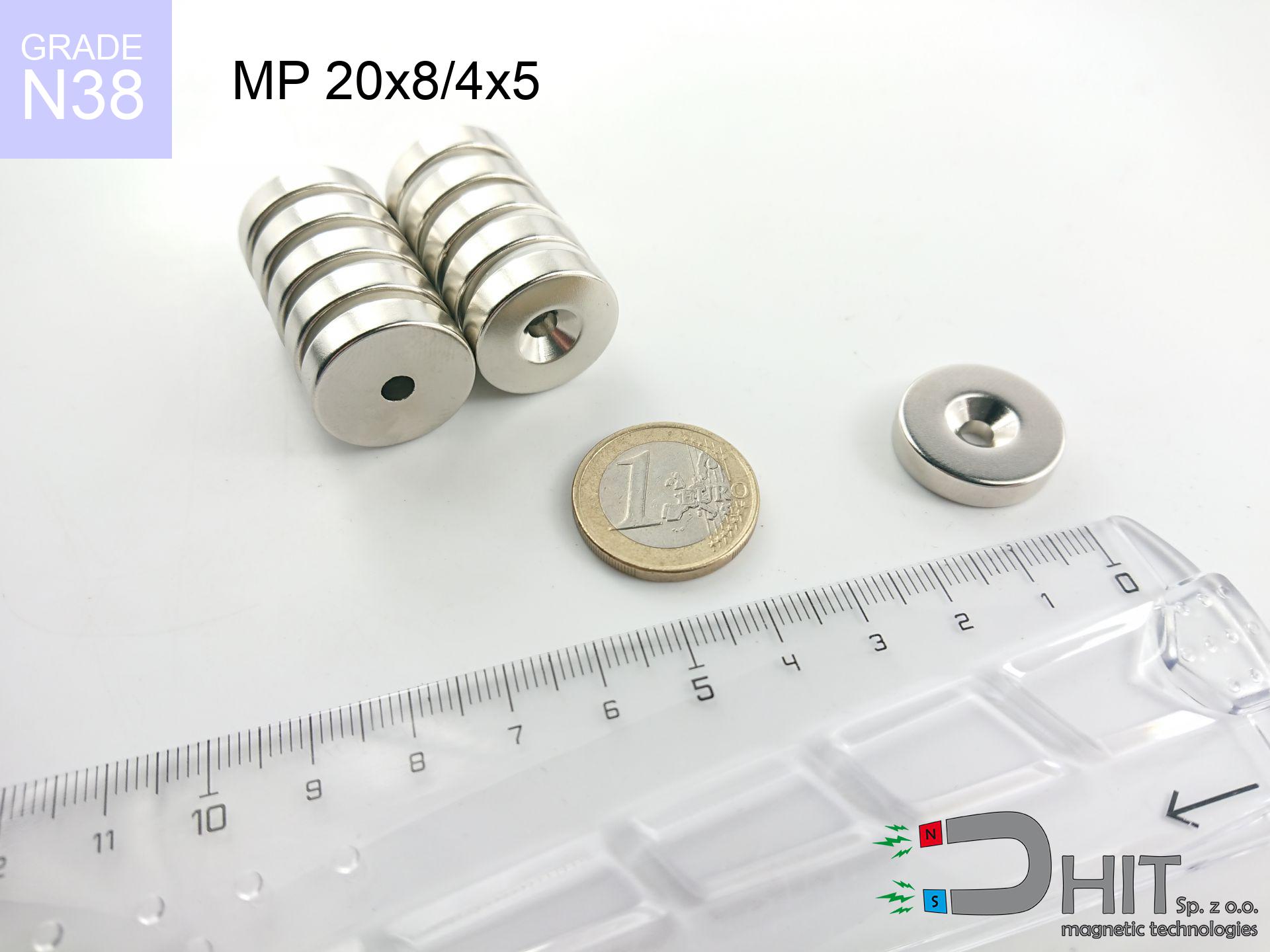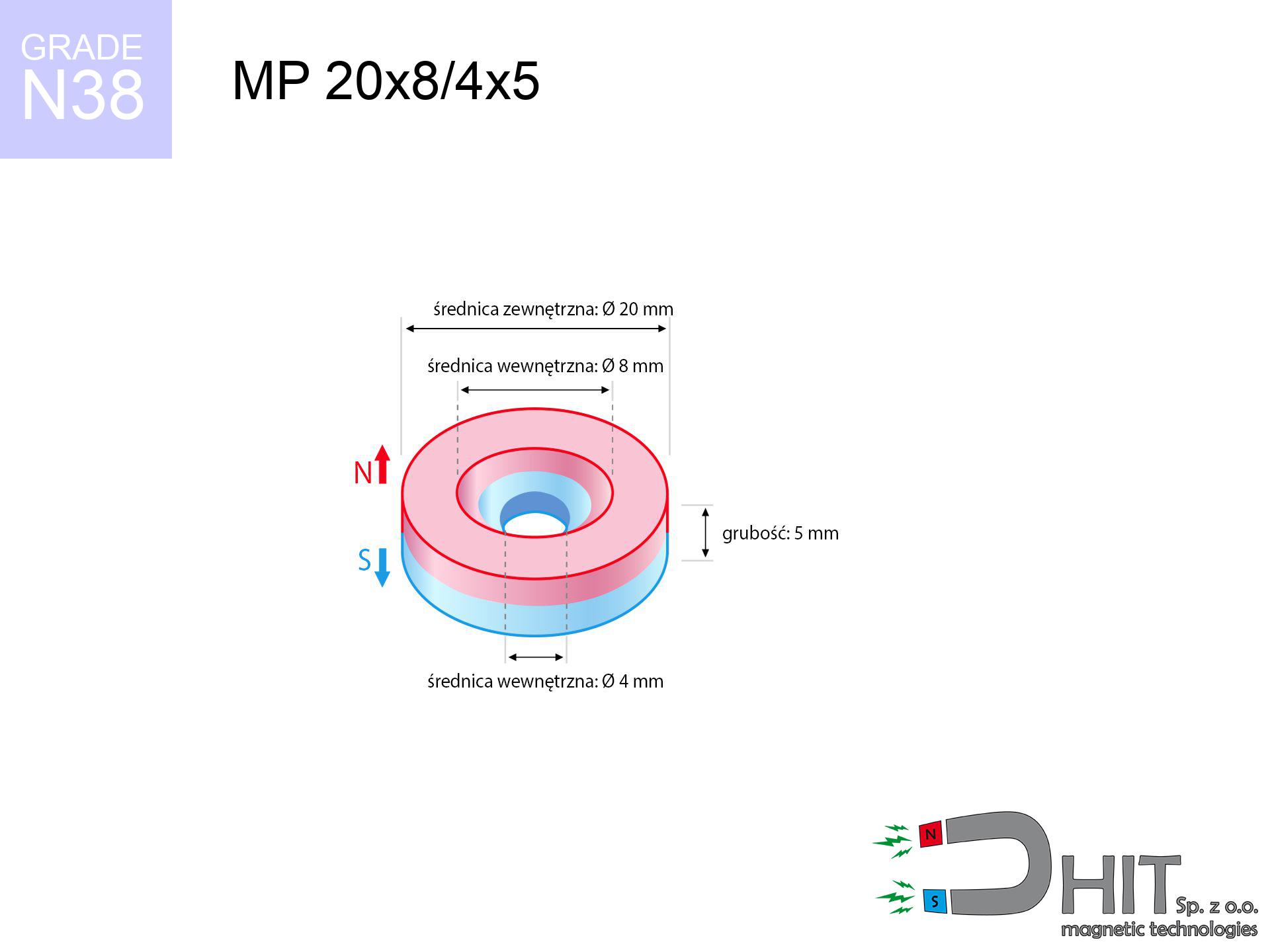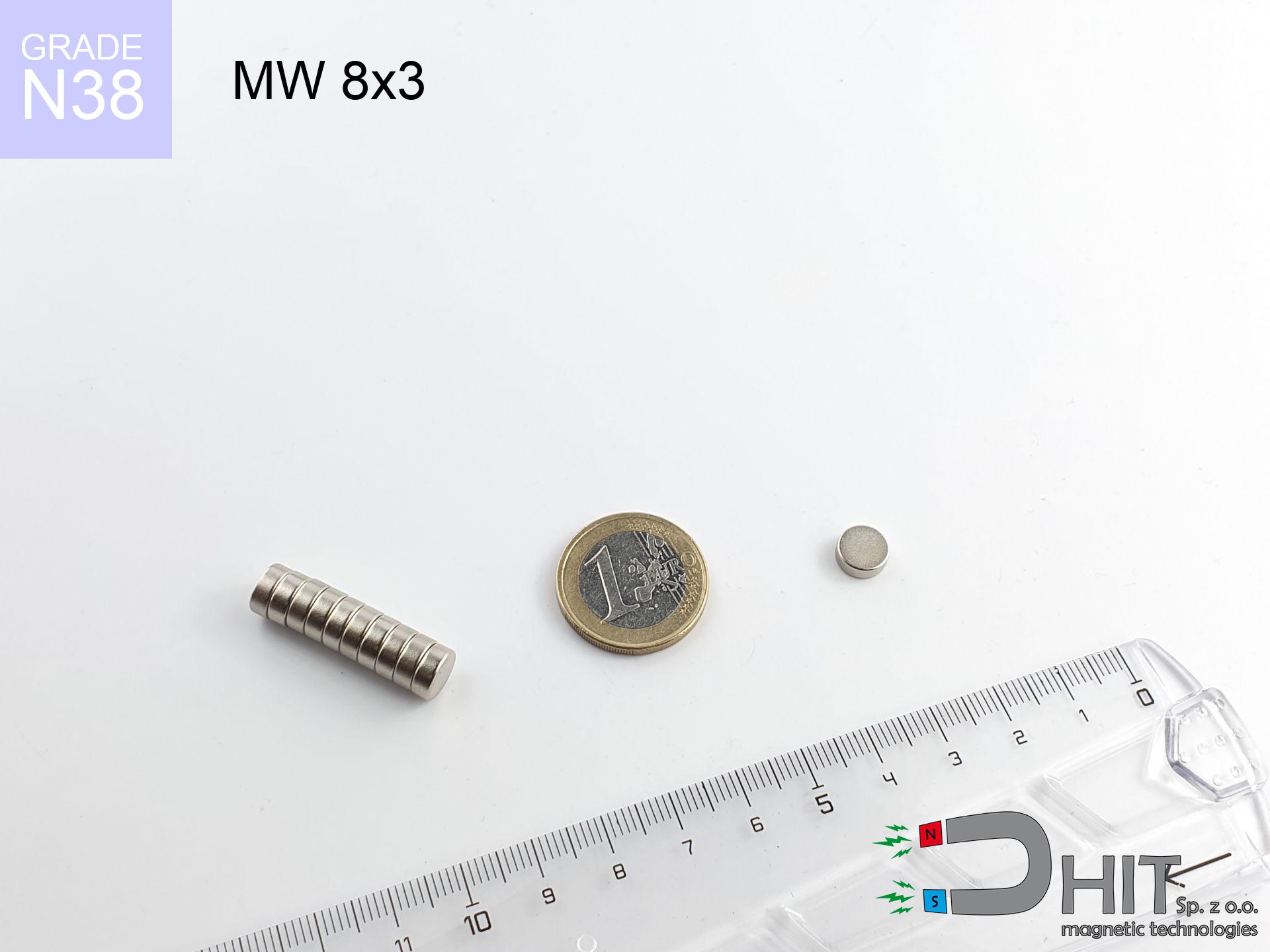MP 20x8/4x5 / N38 - ring magnet
ring magnet
Catalog no 030333
GTIN/EAN: 5906301812272
Diameter
20 mm [±0,1 mm]
internal diameter Ø
8/4 mm [±0,1 mm]
Height
5 mm [±0,1 mm]
Weight
11.31 g
Magnetization Direction
↑ axial
Load capacity
6.65 kg / 65.21 N
Magnetic Induction
277.16 mT / 2772 Gs
Coating
[NiCuNi] Nickel
7.75 ZŁ with VAT / pcs + price for transport
6.30 ZŁ net + 23% VAT / pcs
bulk discounts:
Need more?
Call us
+48 22 499 98 98
if you prefer get in touch through
request form
our website.
Force and structure of magnetic components can be tested on our
power calculator.
Orders submitted before 14:00 will be dispatched today!
Physical properties - MP 20x8/4x5 / N38 - ring magnet
Specification / characteristics - MP 20x8/4x5 / N38 - ring magnet
| properties | values |
|---|---|
| Cat. no. | 030333 |
| GTIN/EAN | 5906301812272 |
| Production/Distribution | Dhit sp. z o.o. |
| Country of origin | Poland / China / Germany |
| Customs code | 85059029 |
| Diameter | 20 mm [±0,1 mm] |
| internal diameter Ø | 8/4 mm [±0,1 mm] |
| Height | 5 mm [±0,1 mm] |
| Weight | 11.31 g |
| Magnetization Direction | ↑ axial |
| Load capacity ~ ? | 6.65 kg / 65.21 N |
| Magnetic Induction ~ ? | 277.16 mT / 2772 Gs |
| Coating | [NiCuNi] Nickel |
| Manufacturing Tolerance | ±0.1 mm |
Magnetic properties of material N38
| properties | values | units |
|---|---|---|
| remenance Br [min. - max.] ? | 12.2-12.6 | kGs |
| remenance Br [min. - max.] ? | 1220-1260 | mT |
| coercivity bHc ? | 10.8-11.5 | kOe |
| coercivity bHc ? | 860-915 | kA/m |
| actual internal force iHc | ≥ 12 | kOe |
| actual internal force iHc | ≥ 955 | kA/m |
| energy density [min. - max.] ? | 36-38 | BH max MGOe |
| energy density [min. - max.] ? | 287-303 | BH max KJ/m |
| max. temperature ? | ≤ 80 | °C |
Physical properties of sintered neodymium magnets Nd2Fe14B at 20°C
| properties | values | units |
|---|---|---|
| Vickers hardness | ≥550 | Hv |
| Density | ≥7.4 | g/cm3 |
| Curie Temperature TC | 312 - 380 | °C |
| Curie Temperature TF | 593 - 716 | °F |
| Specific resistance | 150 | μΩ⋅cm |
| Bending strength | 250 | MPa |
| Compressive strength | 1000~1100 | MPa |
| Thermal expansion parallel (∥) to orientation (M) | (3-4) x 10-6 | °C-1 |
| Thermal expansion perpendicular (⊥) to orientation (M) | -(1-3) x 10-6 | °C-1 |
| Young's modulus | 1.7 x 104 | kg/mm² |
Technical simulation of the assembly - report
Presented information constitute the outcome of a engineering simulation. Results were calculated on algorithms for the material Nd2Fe14B. Real-world parameters may deviate from the simulation results. Use these calculations as a reference point for designers.
Table 1: Static force (pull vs gap) - power drop
MP 20x8/4x5 / N38
| Distance (mm) | Induction (Gauss) / mT | Pull Force (kg/lbs/g/N) | Risk Status |
|---|---|---|---|
| 0 mm |
2424 Gs
242.4 mT
|
6.65 kg / 14.66 pounds
6650.0 g / 65.2 N
|
strong |
| 1 mm |
2265 Gs
226.5 mT
|
5.81 kg / 12.80 pounds
5807.9 g / 57.0 N
|
strong |
| 2 mm |
2070 Gs
207.0 mT
|
4.85 kg / 10.69 pounds
4851.0 g / 47.6 N
|
strong |
| 3 mm |
1858 Gs
185.8 mT
|
3.91 kg / 8.61 pounds
3906.5 g / 38.3 N
|
strong |
| 5 mm |
1437 Gs
143.7 mT
|
2.34 kg / 5.16 pounds
2338.7 g / 22.9 N
|
strong |
| 10 mm |
691 Gs
69.1 mT
|
0.54 kg / 1.19 pounds
540.5 g / 5.3 N
|
weak grip |
| 15 mm |
343 Gs
34.3 mT
|
0.13 kg / 0.29 pounds
133.3 g / 1.3 N
|
weak grip |
| 20 mm |
186 Gs
18.6 mT
|
0.04 kg / 0.09 pounds
39.3 g / 0.4 N
|
weak grip |
| 30 mm |
70 Gs
7.0 mT
|
0.01 kg / 0.01 pounds
5.5 g / 0.1 N
|
weak grip |
| 50 mm |
18 Gs
1.8 mT
|
0.00 kg / 0.00 pounds
0.4 g / 0.0 N
|
weak grip |
Table 2: Vertical load (wall)
MP 20x8/4x5 / N38
| Distance (mm) | Friction coefficient | Pull Force (kg/lbs/g/N) |
|---|---|---|
| 0 mm | Stal (~0.2) |
1.33 kg / 2.93 pounds
1330.0 g / 13.0 N
|
| 1 mm | Stal (~0.2) |
1.16 kg / 2.56 pounds
1162.0 g / 11.4 N
|
| 2 mm | Stal (~0.2) |
0.97 kg / 2.14 pounds
970.0 g / 9.5 N
|
| 3 mm | Stal (~0.2) |
0.78 kg / 1.72 pounds
782.0 g / 7.7 N
|
| 5 mm | Stal (~0.2) |
0.47 kg / 1.03 pounds
468.0 g / 4.6 N
|
| 10 mm | Stal (~0.2) |
0.11 kg / 0.24 pounds
108.0 g / 1.1 N
|
| 15 mm | Stal (~0.2) |
0.03 kg / 0.06 pounds
26.0 g / 0.3 N
|
| 20 mm | Stal (~0.2) |
0.01 kg / 0.02 pounds
8.0 g / 0.1 N
|
| 30 mm | Stal (~0.2) |
0.00 kg / 0.00 pounds
2.0 g / 0.0 N
|
| 50 mm | Stal (~0.2) |
0.00 kg / 0.00 pounds
0.0 g / 0.0 N
|
Table 3: Wall mounting (sliding) - behavior on slippery surfaces
MP 20x8/4x5 / N38
| Surface type | Friction coefficient / % Mocy | Max load (kg/lbs/g/N) |
|---|---|---|
| Raw steel |
µ = 0.3
30% Nominalnej Siły
|
2.00 kg / 4.40 pounds
1995.0 g / 19.6 N
|
| Painted steel (standard) |
µ = 0.2
20% Nominalnej Siły
|
1.33 kg / 2.93 pounds
1330.0 g / 13.0 N
|
| Oily/slippery steel |
µ = 0.1
10% Nominalnej Siły
|
0.67 kg / 1.47 pounds
665.0 g / 6.5 N
|
| Magnet with anti-slip rubber |
µ = 0.5
50% Nominalnej Siły
|
3.33 kg / 7.33 pounds
3325.0 g / 32.6 N
|
Table 4: Steel thickness (substrate influence) - sheet metal selection
MP 20x8/4x5 / N38
| Steel thickness (mm) | % power | Real pull force (kg/lbs/g/N) |
|---|---|---|
| 0.5 mm |
|
0.67 kg / 1.47 pounds
665.0 g / 6.5 N
|
| 1 mm |
|
1.66 kg / 3.67 pounds
1662.5 g / 16.3 N
|
| 2 mm |
|
3.33 kg / 7.33 pounds
3325.0 g / 32.6 N
|
| 3 mm |
|
4.99 kg / 11.00 pounds
4987.5 g / 48.9 N
|
| 5 mm |
|
6.65 kg / 14.66 pounds
6650.0 g / 65.2 N
|
| 10 mm |
|
6.65 kg / 14.66 pounds
6650.0 g / 65.2 N
|
| 11 mm |
|
6.65 kg / 14.66 pounds
6650.0 g / 65.2 N
|
| 12 mm |
|
6.65 kg / 14.66 pounds
6650.0 g / 65.2 N
|
Table 5: Thermal stability (stability) - resistance threshold
MP 20x8/4x5 / N38
| Ambient temp. (°C) | Power loss | Remaining pull (kg/lbs/g/N) | Status |
|---|---|---|---|
| 20 °C | 0.0% |
6.65 kg / 14.66 pounds
6650.0 g / 65.2 N
|
OK |
| 40 °C | -2.2% |
6.50 kg / 14.34 pounds
6503.7 g / 63.8 N
|
OK |
| 60 °C | -4.4% |
6.36 kg / 14.02 pounds
6357.4 g / 62.4 N
|
|
| 80 °C | -6.6% |
6.21 kg / 13.69 pounds
6211.1 g / 60.9 N
|
|
| 100 °C | -28.8% |
4.73 kg / 10.44 pounds
4734.8 g / 46.4 N
|
Table 6: Two magnets (attraction) - forces in the system
MP 20x8/4x5 / N38
| Gap (mm) | Attraction (kg/lbs) (N-S) | Shear Force (kg/lbs/g/N) | Repulsion (kg/lbs) (N-N) |
|---|---|---|---|
| 0 mm |
9.28 kg / 20.47 pounds
4 012 Gs
|
1.39 kg / 3.07 pounds
1393 g / 13.7 N
|
N/A |
| 1 mm |
8.73 kg / 19.25 pounds
4 701 Gs
|
1.31 kg / 2.89 pounds
1310 g / 12.8 N
|
7.86 kg / 17.33 pounds
~0 Gs
|
| 2 mm |
8.11 kg / 17.88 pounds
4 530 Gs
|
1.22 kg / 2.68 pounds
1216 g / 11.9 N
|
7.30 kg / 16.09 pounds
~0 Gs
|
| 3 mm |
7.45 kg / 16.42 pounds
4 342 Gs
|
1.12 kg / 2.46 pounds
1117 g / 11.0 N
|
6.70 kg / 14.78 pounds
~0 Gs
|
| 5 mm |
6.10 kg / 13.45 pounds
3 930 Gs
|
0.92 kg / 2.02 pounds
915 g / 9.0 N
|
5.49 kg / 12.11 pounds
~0 Gs
|
| 10 mm |
3.27 kg / 7.20 pounds
2 875 Gs
|
0.49 kg / 1.08 pounds
490 g / 4.8 N
|
2.94 kg / 6.48 pounds
~0 Gs
|
| 20 mm |
0.75 kg / 1.66 pounds
1 382 Gs
|
0.11 kg / 0.25 pounds
113 g / 1.1 N
|
0.68 kg / 1.50 pounds
~0 Gs
|
| 50 mm |
0.02 kg / 0.04 pounds
220 Gs
|
0.00 kg / 0.01 pounds
3 g / 0.0 N
|
0.02 kg / 0.04 pounds
~0 Gs
|
| 60 mm |
0.01 kg / 0.02 pounds
139 Gs
|
0.00 kg / 0.00 pounds
1 g / 0.0 N
|
0.00 kg / 0.00 pounds
~0 Gs
|
| 70 mm |
0.00 kg / 0.01 pounds
93 Gs
|
0.00 kg / 0.00 pounds
1 g / 0.0 N
|
0.00 kg / 0.00 pounds
~0 Gs
|
| 80 mm |
0.00 kg / 0.00 pounds
65 Gs
|
0.00 kg / 0.00 pounds
0 g / 0.0 N
|
0.00 kg / 0.00 pounds
~0 Gs
|
| 90 mm |
0.00 kg / 0.00 pounds
47 Gs
|
0.00 kg / 0.00 pounds
0 g / 0.0 N
|
0.00 kg / 0.00 pounds
~0 Gs
|
| 100 mm |
0.00 kg / 0.00 pounds
35 Gs
|
0.00 kg / 0.00 pounds
0 g / 0.0 N
|
0.00 kg / 0.00 pounds
~0 Gs
|
Table 7: Safety (HSE) (electronics) - precautionary measures
MP 20x8/4x5 / N38
| Object / Device | Limit (Gauss) / mT | Safe distance |
|---|---|---|
| Pacemaker | 5 Gs (0.5 mT) | 8.0 cm |
| Hearing aid | 10 Gs (1.0 mT) | 6.5 cm |
| Mechanical watch | 20 Gs (2.0 mT) | 5.0 cm |
| Mobile device | 40 Gs (4.0 mT) | 4.0 cm |
| Remote | 50 Gs (5.0 mT) | 3.5 cm |
| Payment card | 400 Gs (40.0 mT) | 1.5 cm |
| HDD hard drive | 600 Gs (60.0 mT) | 1.5 cm |
Table 8: Dynamics (cracking risk) - collision effects
MP 20x8/4x5 / N38
| Start from (mm) | Speed (km/h) | Energy (J) | Predicted outcome |
|---|---|---|---|
| 10 mm |
25.67 km/h
(7.13 m/s)
|
0.29 J | |
| 30 mm |
42.38 km/h
(11.77 m/s)
|
0.78 J | |
| 50 mm |
54.68 km/h
(15.19 m/s)
|
1.30 J | |
| 100 mm |
77.33 km/h
(21.48 m/s)
|
2.61 J |
Table 9: Anti-corrosion coating durability
MP 20x8/4x5 / N38
| Technical parameter | Value / Description |
|---|---|
| Coating type | [NiCuNi] Nickel |
| Layer structure | Nickel - Copper - Nickel |
| Layer thickness | 10-20 µm |
| Salt spray test (SST) ? | 24 h |
| Recommended environment | Indoors only (dry) |
Table 10: Electrical data (Flux)
MP 20x8/4x5 / N38
| Parameter | Value | SI Unit / Description |
|---|---|---|
| Magnetic Flux | 7 218 Mx | 72.2 µWb |
| Pc Coefficient | 0.31 | Low (Flat) |
Table 11: Underwater work (magnet fishing)
MP 20x8/4x5 / N38
| Environment | Effective steel pull | Effect |
|---|---|---|
| Air (land) | 6.65 kg | Standard |
| Water (riverbed) |
7.61 kg
(+0.96 kg buoyancy gain)
|
+14.5% |
1. Vertical hold
*Note: On a vertical wall, the magnet holds only approx. 20-30% of its perpendicular strength.
2. Steel saturation
*Thin steel (e.g. computer case) drastically weakens the holding force.
3. Power loss vs temp
*For standard magnets, the critical limit is 80°C.
4. Demagnetization curve and operating point (B-H)
chart generated for the permeance coefficient Pc (Permeance Coefficient) = 0.31
This simulation demonstrates the magnetic stability of the selected magnet under specific geometric conditions. The solid red line represents the demagnetization curve (material potential), while the dashed blue line is the load line based on the magnet's geometry. The Pc (Permeance Coefficient), also known as the load line slope, is a dimensionless value that describes the relationship between the magnet's shape and its magnetic stability. The intersection of these two lines (the black dot) is the operating point — it determines the actual magnetic flux density generated by the magnet in this specific configuration. A higher Pc value means the magnet is more 'slender' (tall relative to its area), resulting in a higher operating point and better resistance to irreversible demagnetization caused by external fields or temperature. A value of 0.42 is relatively low (typical for flat magnets), meaning the operating point is closer to the 'knee' of the curve — caution is advised when operating at temperatures near the maximum limit to avoid strength loss.
Chemical composition
| iron (Fe) | 64% – 68% |
| neodymium (Nd) | 29% – 32% |
| boron (B) | 1.1% – 1.2% |
| dysprosium (Dy) | 0.5% – 2.0% |
| coating (Ni-Cu-Ni) | < 0.05% |
Environmental data
| recyclability (EoL) | 100% |
| recycled raw materials | ~10% (pre-cons) |
| carbon footprint | low / zredukowany |
| waste code (EWC) | 16 02 16 |
View also proposals
Advantages as well as disadvantages of Nd2Fe14B magnets.
Benefits
- They retain magnetic properties for almost 10 years – the loss is just ~1% (according to analyses),
- They are noted for resistance to demagnetization induced by external field influence,
- In other words, due to the smooth surface of gold, the element gains visual value,
- Magnetic induction on the surface of the magnet turns out to be very high,
- Thanks to resistance to high temperature, they can operate (depending on the shape) even at temperatures up to 230°C and higher...
- Thanks to modularity in designing and the ability to modify to unusual requirements,
- Fundamental importance in modern industrial fields – they serve a role in mass storage devices, electromotive mechanisms, precision medical tools, and other advanced devices.
- Thanks to their power density, small magnets offer high operating force, in miniature format,
Disadvantages
- Brittleness is one of their disadvantages. Upon intense impact they can fracture. We recommend keeping them in a special holder, which not only secures them against impacts but also raises their durability
- We warn that neodymium magnets can reduce their strength at high temperatures. To prevent this, we advise our specialized [AH] magnets, which work effectively even at 230°C.
- When exposed to humidity, magnets usually rust. To use them in conditions outside, it is recommended to use protective magnets, such as magnets in rubber or plastics, which prevent oxidation and corrosion.
- We suggest a housing - magnetic mount, due to difficulties in realizing threads inside the magnet and complicated forms.
- Health risk resulting from small fragments of magnets pose a threat, in case of ingestion, which gains importance in the context of child safety. Furthermore, small components of these magnets are able to disrupt the diagnostic process medical in case of swallowing.
- Higher cost of purchase is a significant factor to consider compared to ceramic magnets, especially in budget applications
Pull force analysis
Best holding force of the magnet in ideal parameters – what affects it?
- using a base made of mild steel, functioning as a circuit closing element
- possessing a massiveness of min. 10 mm to ensure full flux closure
- characterized by even structure
- without any air gap between the magnet and steel
- for force applied at a right angle (in the magnet axis)
- in stable room temperature
Lifting capacity in practice – influencing factors
- Air gap (betwixt the magnet and the metal), as even a tiny distance (e.g. 0.5 mm) results in a drastic drop in force by up to 50% (this also applies to varnish, corrosion or debris).
- Force direction – remember that the magnet has greatest strength perpendicularly. Under sliding down, the holding force drops drastically, often to levels of 20-30% of the nominal value.
- Wall thickness – the thinner the sheet, the weaker the hold. Magnetic flux passes through the material instead of generating force.
- Metal type – different alloys attracts identically. Alloy additives weaken the attraction effect.
- Surface finish – full contact is obtained only on smooth steel. Rough texture create air cushions, weakening the magnet.
- Temperature – heating the magnet causes a temporary drop of force. Check the thermal limit for a given model.
Lifting capacity was measured with the use of a steel plate with a smooth surface of suitable thickness (min. 20 mm), under perpendicular detachment force, however under attempts to slide the magnet the holding force is lower. Moreover, even a minimal clearance between the magnet’s surface and the plate reduces the holding force.
H&S for magnets
Pinching danger
Large magnets can crush fingers instantly. Never place your hand between two attracting surfaces.
Shattering risk
Despite metallic appearance, neodymium is brittle and cannot withstand shocks. Avoid impacts, as the magnet may shatter into hazardous fragments.
GPS Danger
GPS units and mobile phones are highly sensitive to magnetism. Direct contact with a strong magnet can decalibrate the sensors in your phone.
Flammability
Machining of NdFeB material carries a risk of fire hazard. Neodymium dust oxidizes rapidly with oxygen and is hard to extinguish.
Handling rules
Handle magnets consciously. Their huge power can shock even professionals. Stay alert and respect their power.
Medical implants
For implant holders: Powerful magnets disrupt electronics. Maintain at least 30 cm distance or ask another person to handle the magnets.
Keep away from computers
Equipment safety: Strong magnets can ruin payment cards and delicate electronics (heart implants, medical aids, mechanical watches).
Maximum temperature
Regular neodymium magnets (N-type) lose magnetization when the temperature goes above 80°C. The loss of strength is permanent.
This is not a toy
Neodymium magnets are not toys. Eating a few magnets may result in them pinching intestinal walls, which constitutes a direct threat to life and necessitates urgent medical intervention.
Allergy Warning
It is widely known that the nickel plating (standard magnet coating) is a strong allergen. For allergy sufferers, prevent direct skin contact and choose versions in plastic housing.




![HH 42x8.8 [M6] / N38 - through hole magnetic holder HH 42x8.8 [M6] / N38 - through hole magnetic holder](https://cdn3.dhit.pl/graphics/products/hh-42x8.8-m6-hin.jpg)


![UI 45x13x5 [M301] / N38 - badge holder UI 45x13x5 [M301] / N38 - badge holder](https://cdn3.dhit.pl/graphics/products/ui45x13x5-m301-vud.jpg)

